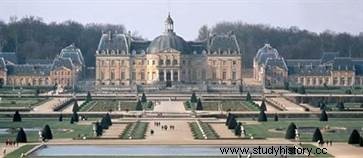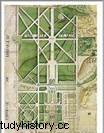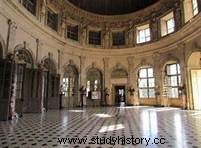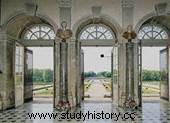 A model of French classicism, the Château de Vaux-le-Vicomte (near Melun, in Seine-et-Marne) was built from 1656 for Nicolas Fouquet according to a plan designed in part by Louis Le Vau. Equipped with a large terrace in front of which extend gardens created by Le Nôtre, it was the place of sumptuous parties, in particular that of August 17, 1661 which precipitated the disgrace of the superintendent of Finances. In a new style, the castle was the true precursor of Versailles. Since 1965, the castle of Vaux-le-Vicomte has been listed as a historic monument.
A model of French classicism, the Château de Vaux-le-Vicomte (near Melun, in Seine-et-Marne) was built from 1656 for Nicolas Fouquet according to a plan designed in part by Louis Le Vau. Equipped with a large terrace in front of which extend gardens created by Le Nôtre, it was the place of sumptuous parties, in particular that of August 17, 1661 which precipitated the disgrace of the superintendent of Finances. In a new style, the castle was the true precursor of Versailles. Since 1965, the castle of Vaux-le-Vicomte has been listed as a historic monument.
Vaux-le-Vicomte de Fouquet
Becoming Superintendent of Finance in 1653, Nicolas Fouquet, at the head of an immense fortune, decided to have a house built worthy of his position. Three artists of confirmed talent — the architect Louis Le Vau, the painter Charles Le Brun and the gardener-landscaper André Le Nôtre — were commissioned to build on the seigniory he owned in French Brie an area without precedent in France. From 1656, 18,000 workers took part, for five years, in the construction of the castle and its park:to carry out the project, three villages were razed, including the one that gave its name to the castle; a factory is created in the neighboring village of Maincy for the weaving of hangings. Fouquet, as a wise client and patron with great artistic taste with an instinct for the beautiful and the delicate, acquired the Vaux-le-Vicomte estate in 1641. Helped and surrounded by Le Nôtre, Le Brun and Le Vau, all four are from the same generation and are settling in during the works.
Gardens are created before buildings are constructed, as in many residences. Fouquet asks for the construction of a barnyard, a flowerbed, a vegetable garden and an orchard. Le Nôtre is working on the creation of three parterres (north-south axis, embroidery parterre, lawn parterre) and a west-east transverse axis with pond and vegetable garden. To the east, we go through the embroidery beds, the crown, the water grid before arriving at the cave and the waterfalls. After the acquisition of the Etang de Vaux, the gardens were extended to the south and the Grand Canal was dug. More than 1000 m separate the castle from the end of the gardens with the statue of Hercules as a point of honor, above the cave.
 Vaux-le-Vicomte is the seat of the kingdom's most popular festivals, the story of which can be found in Jean de La Fontaine and Madeleine de Scudéry. The finest of celebrations took place in August 1661, in the presence of Louis XIV. Vatel, who entered Fouquet's service around 1655, organized the festivities, offering an "ambiguous", a new kind of cold meal where all the dishes were served at the same time, like our current buffets. Entertainment is plentiful near the water gate, with theater and fireworks lighting up the Grand Canal. Nicolas Fouquet sentenced to life imprisonment, the castle was sealed until 1673, when it was returned to the superintendent's widow. In the meantime, many sculptures were moved to Versailles, whose expansion work, which began in 1661, brought together the three creators of Vaux-le-Vicomte.
Vaux-le-Vicomte is the seat of the kingdom's most popular festivals, the story of which can be found in Jean de La Fontaine and Madeleine de Scudéry. The finest of celebrations took place in August 1661, in the presence of Louis XIV. Vatel, who entered Fouquet's service around 1655, organized the festivities, offering an "ambiguous", a new kind of cold meal where all the dishes were served at the same time, like our current buffets. Entertainment is plentiful near the water gate, with theater and fireworks lighting up the Grand Canal. Nicolas Fouquet sentenced to life imprisonment, the castle was sealed until 1673, when it was returned to the superintendent's widow. In the meantime, many sculptures were moved to Versailles, whose expansion work, which began in 1661, brought together the three creators of Vaux-le-Vicomte.
After Fouquet was arrested for embezzlement in 1661, the estate went to sleep. His widow eventually sells the lands, the seigneuries of Melun and Vaux-Le-Vicomte. Marshal de Villars, raised duke by the king around 1705, bought the properties, changed the name to Vaux-Villars as well as the coat of arms on the pediment of the property. In 1714, his wife Jeanne Angélique hosted a salon there where good society and fine minds jostled.
In the hands of the Choiseul-Praslin
When the Villars died (he in 1734, she in 1763) the estate returned to their son. The Duc de Villars being riddled with debts, resold the whole thing a year later to the Choiseul-Praslin, cousins of the Duc de Choiseul, main minister of Louis XV.
The arms are obviously changed on the pediment; the ground floor is kept, but on the 1st floor, the square rooms become small apartments.
 In 1791, despite the Revolution, the estate was intact, the Praslins having not emigrated. In 1841, the 6th Duke inherited Vaux and got down to repairing the roofs, as well as the lantern of the dome. But in 1847, after a family drama, Vaux plunged back into a long sleep of 30 years:the work stopped, the blinds and the windows were broken, everything was in ruins, the family not having the means to undertake works and almost inevitably the estate is put up for auction.
In 1791, despite the Revolution, the estate was intact, the Praslins having not emigrated. In 1841, the 6th Duke inherited Vaux and got down to repairing the roofs, as well as the lantern of the dome. But in 1847, after a family drama, Vaux plunged back into a long sleep of 30 years:the work stopped, the blinds and the windows were broken, everything was in ruins, the family not having the means to undertake works and almost inevitably the estate is put up for auction.
In June 1875, three lots were composed:the castle, the park, the outbuildings and a farm; a 140 hectare farm; finally, a farm of 200 hectares.
Sommer family restorations
For fear of being badly sold or sold separately, the prefect of the region contacted his friend Alfred Sommer, art lover and cultured, who acquired the set of the estate for 2,275,400 gold francs. More than 5,000,000 gold francs will be needed to restore everything.
The Sommers first settled there in July 1877, in summer and fall, returning to Paris for the winter. It will be like this until 1940. The task is hard, the gardens are fallow. Fortunately, there remain the established drawings of the time of Nicolas Fouquet. Everything will be restored:the waterfalls, the grotto, the water grid, and the statue of Hercules reinstalled in the north-south axis above the grotto.
His son Edme continues to refurnish the castle, buys paintings including a portrait of Nicolas Fouquet, takes care of the parterre des bordersies, but always with the concern of good financial management of the domain. The 1st World War will not do any damage:Edme is incorporated as a car driver, while his wife installs a hospital in the outbuildings:1115 wounded will be treated there. She was congratulated by Clémenceau then by Foch and in 1918 received the Croix de Guerre.
When Edme Sommer died in 1945, the property was divided between the four nieces and nephews. His wife remains usufructuary and continues to take care of the management of the estate, while Jean de Vogüé becomes owner of Vaux-le-Vicomte.
Vaux-le-Vicomte from father to son
 The maintenance and conservation requiring a great fortune, the de Vogüé decided to open the garden to the public in return for an entry ticket. The estate was then considered one of the most prestigious French monuments, so much so that foreign personalities asked to visit the places like Elizabeth II of England. In 1968, Patrice, the son of Jean de Vogüé took over the reins. In an attempt to balance the accounts, he decided to show the castle around, to create activities, to open the kitchen in the basement to visits and to set up a crew museum in the stables housing old cars, as well as to accept shots for the cinema and for television reports.
The maintenance and conservation requiring a great fortune, the de Vogüé decided to open the garden to the public in return for an entry ticket. The estate was then considered one of the most prestigious French monuments, so much so that foreign personalities asked to visit the places like Elizabeth II of England. In 1968, Patrice, the son of Jean de Vogüé took over the reins. In an attempt to balance the accounts, he decided to show the castle around, to create activities, to open the kitchen in the basement to visits and to set up a crew museum in the stables housing old cars, as well as to accept shots for the cinema and for television reports.
In 1990, the castle was opened in the summer, where candlelight evenings were organized with 2,000 candles and fireworks. Around the year 2000, 50 films and television films were set in the Vaux estate; although their stories are set in Versailles, the productions prefer the setting of Vaux for filming... Since 2005, a "Grand Siècle" day has taken place annually with lunch on the grass, demonstration of falconry, costumes marking the art of living French style.
 Nowadays, the three sons who lived in the southeast wing of the castle until the open to the public where they moved to the Pavilion (south wing of the Grands Communs), succeeded their parents at the head of the estate, having in charge of perpetuating traditions, reducing deficits, attracting more and more public which was already significant in 2013 with more than 305,000 visitors.
Nowadays, the three sons who lived in the southeast wing of the castle until the open to the public where they moved to the Pavilion (south wing of the Grands Communs), succeeded their parents at the head of the estate, having in charge of perpetuating traditions, reducing deficits, attracting more and more public which was already significant in 2013 with more than 305,000 visitors.
Let's follow the visitors and now enter this magnificent domain. We cross the gate and the monumental gates, cross the forecourt and climb the 20 steps of the perron… the vestibule and the oval lounge welcome us warmly. Let us be transported in this masterpiece of the French architect, celebrating the power and the glory of Fouquet. Let's discover the ceremonial apartment on the ground floor, then the current library (antechamber of the king's apartment at the time of Louis XIV) being one of the most beautiful rooms in the castle with its sublime French ceilings and Italian style, wealth of Vaux-le-Vicomte. Finally, from the oval lounge, let's access the gardens, as designed by ours, there was a time...
To go further
- The castle of Vaux-le-Vicomte, by Jean-Marie Pérouse de Montclos. Scala, 2016.
- One day in Vaux-le-Vicomte, the Vogüé brothers. Flammarion, 2015.
